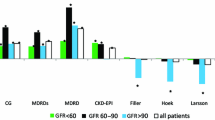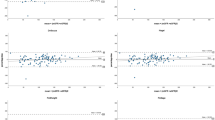Abstract
Objective
To assess the accuracy of 4 mathematical equations used to estimate creatinine clearance versus the 24-h creatinine clearance in ICU patients.
Design
Prospective study of renal function prediction.
Setting
The general adult ICUs of 3 metropolitan hospitals.
Patients
199 critically ill patients with indwelling foley catheters.
Intervention and measurements
Routine 24 h creatinine clearances were evaluated only in patients whose urine volume recorded by the nurses was within 10% of the laboratory's measured volume. Four mathematical equations utilizing age, sex, body weight, height, and plasma creatinine were used as a comparison. There was no difference in estimated creatinine clearance by 3 published methods when the 24 h creatinine clearance exceeded 100 ml/min. When the 24 h creatinine clearance was less than 100 ml/min, however, one prediction equation adjusted for lean body weight (LBW), was the most accurate. This equation accurately predicted creatinine clearance in the range of 30–100 ml/min and slightly overestimated creatinine clearance at 0–30 ml/min (p<0.01, ANOVA all groups,p<0.05 Fisher and Scheffé post-hoc tests) with a mean difference ±95% confidence interval of −5±3.1 ml/min.
Conclusion
An initial rapid estimate of creatinine clearance in critically ill ICU patients with reduced renal function can be determined by an equation adjusted for LBW.
Similar content being viewed by others
References
Scoy REV, Wilson WR (1987) Antimicrobial agents in adult patients with renal insufficiency: initial dosage and general recommendations. Mayo Clinic Proc 62:1142–1145
Bennett WM, Muther RS, Parker RA, Feig P, Morrison G, Golper TA, Singer I (1980) Drug therapy in renal failure. Dosing guidelines for adults. Ann Intern Med 93:62–89
Bennett WM (1979) Drug prescribing in renal failure. Drugs 17:111–123
Kunin CM, Rees SB, Merrill JP, Finland M (1959) Persistence of antibiotics in blood of patients with acute renal failure. I. Tetracycline and chlortetracycline. J Clin Invest 38:1487–1497
Narayanan S, Appleton HD (1980) Creatinine: a review. Clin Chem 26:1119–1126
Kim KE, Onesti G, Ramirez O, Brest AN, Swartz C (1969) Creatinine clearance in renal disease. A reappraisal. Br Med J 4:11–14
Rosenbaum JL (1970) Evaluation of clearance studies in chronic kidney disease. J Chronic Dis 22:507–514
Bauer JH, Brooks CS, Burch RN (1982) Renal function studies in man with advanced renal insufficiency. Am J Kidney Dis 2:30–35
Luke DR, Halstenson CE, Opsahl JA, Matzke GR (1990) Validity of creatinine clearance estimates in the assessment of renal function. Clin Pharmacol Ther 48:503–508
Wilsen RF, Soullier G (1980) The validity of two-hour creatinine clearance studies in critically ill patients. Crit Care Med 8:281–284
Sladon RN, Endo E, Harrison T (1987) Two-hour versus 22 h creatinine clearance in critically ill patients. Anesthesiology 67:1013–1016
Cockcroft DW, Gault MH (1976) Prediction of creatinine clearance from serum creatinine. Nephron 16:31–41
Jelliffe RW (1973) Creatinine clearance: bedside estimate. Ann Intern Med 79:604–605
Mawer CE, Knowles BR, Lucas SB, Stirland RA, Tooth JA (1972) Computer-assisted prescribing of kanamycin for patients with renal insufficiency. Lancet I:12–15
Hull JH, Hak LJ, Koch GC, Wargin WA, Chi SL, Mattocks AM. Influence of range of renal function and liver disease on predictability of creatinine clearance. Clin Pharmacol Ther 29:516–521
Devine B (1974) Gentamicin therapy. Drug Intell Clin Pharm 8:650–655
Gardner MJ, Altman DG (1986) Confidence intervals rather than P values: estimation rather than hypothesis testing. Br Med J 292:746–750
Anderson MD, Chernow B (1988) Pharmacologic principles. In: Civetta JM, Taylor RW, Kirby RR (eds) Critical care. Lipincott, London Mexico City New York Sao Paulo Sydney, p 489
Townsend PL, Reynolds JR (1991) Applied pharmacokinetics: an overview. In: Rippe JM, Irwin RS, Alpert JS, Fink MP (eds) Intensive care medicine. Little, Brown, and Co., Boston Toronto London, p 1702
Forbes AB, Bruining GJ (1976) Urinary creatinine excretion and lean body mass. Am J Clin Nutr 29:1359–1366
Uauy R, Winterer JC, Bilmazes C, Haverberg LN, Scrimshaw NS, Munro HN, Young VR (1978) The changing pattern of whole body protein metabolism in aging humans. J Gerontol 33:663–671
Rowe JW, Andres R, Tobin JD, Norris AH, Shock NW (1976) The effect of age on creatinine clearance in men: a cross-sectional and longitudinal study. J Gerontol 31:155–163
Trollfors B, Wahl M, Alestig K (1980) Co-trimoxazole, creatinine and renal function. J Infect 2:221–226
Berglund F, Killander J, Pompeius R (1975) Effect of trimethoprimsulfamethoxazole on the renal excretion of creatinine in man. J Urol 114:802–808
Gardner MJ, Altman DG (1988) Estimating with confidence. Br Med J 296:1210–1211
Evans SJW, Mills P, Dawson J (1988) The end of thep value? Br Heart J 60:177–180
Martin C, Ayala M, Bras J, Saux P, Gouin F (1990) Assessment of creatinine clearance in intensive care patients. Crit Care Med 18:1224–1226
Pesola GR, Akhavan I (1990) Urinary creatinine excretion: declining excretion does not mean inadequate collection. Chest 98:116S (Abstract)
Author information
Authors and Affiliations
Rights and permissions
About this article
Cite this article
Pesola, G.R., Akhavan, I., Madu, A. et al. Prediction equation estimates of creatinine clearance in the intensive care unit. Intensive Care Med 19, 39–43 (1993). https://doi.org/10.1007/BF01709276
Received:
Accepted:
Issue Date:
DOI: https://doi.org/10.1007/BF01709276




